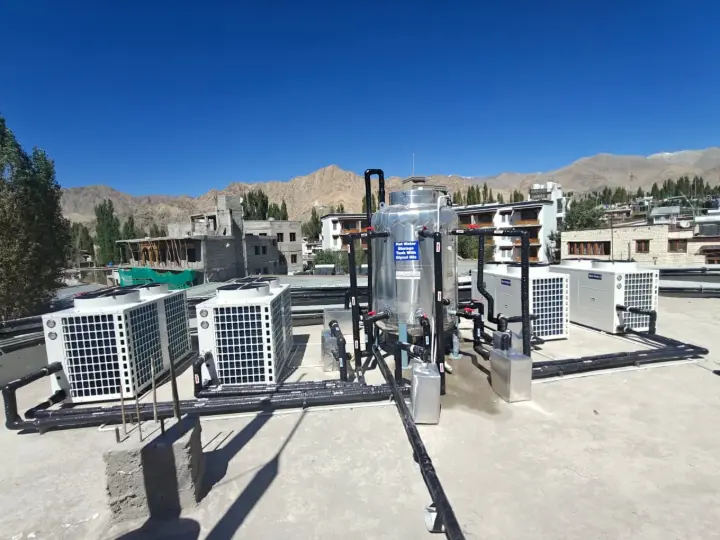Traditional Methods of Heating in Cooling region?
In colder climates, traditional heating methods include direct heating with fires, electric heater, boilers, fireplaces and stoves, and passive heating through architecture. But these resources are non-renewable energy sources and the cost to operate them is also high and they are also harming the environment. Due to advancement in technology and development in the procees. Due to this all of the people can't use it due to its high cost and the method it works.
The solution to this comes EVI heat pump which works on the latest technology which can provide heat upto 60 ° C and can also work in condition like -25 °C.
What are EVI heat pump?
EVI (Enhanced Vapour Injection) heat pumps have become a ground-breaking technology as interest in environmentally friendly and energy-efficient heating systems rises worldwide, particularly in cold countries. Enhanced Vapour Injection, or EVI for short, is a cutting-edge heat pump technology that can function well even in extremely cold outdoor conditions, where conventional heat pumps sometimes lose their effectiveness or cease to function entirely.
EVI heat pumps, in contrast to conventional air-source heat pumps, have a unique compressor that introduces vapour into the cycle at a moderate pressure. EVI systems are perfect for heating homes and businesses in colder climates because of this process, which dramatically increases heating capacity and energy efficiency, particularly in below-freezing conditions.
EVI adds an extra refrigerant vapor injection stage in the compressor circuit. This helps maintain higher pressure and higher evaporation/condensation efficiency even when the outside air is very cold. Many EVI systems also use DC inverter compressors, which adjust their speed to only use as much energy as needed instead of running at one fixed speed. This improves efficiency, reduces wear and tear, and helps maintain stable indoor temperatures.
Here are the main reasons EVI systems outperform traditional heating in colder regions:
| Aspect | Traditional Heating / Standard Heat Pump | EVI Heat Pump |
| Minimum operational temperature | They often lose efficiency or require auxiliary heating below ~ ‑10 °C to ‑15 °C. | Can operate efficiently down to ‑25 °C or even ‑30 °C depending on model. |
| Heating Capacity at Low Temperatures | Drops significantly; more electricity needed; performance unstable. | Maintains higher heating output thanks to vapor injection; better COP (coefficient of performance) in cold. |
| Efficiency (COP) in Cold | COP declines as outdoor temp falls, sometimes becoming just marginal. | EVI keeps the COP higher in cold, meaning more heat per unit electricity. |
| Energy Costs | Higher with resistive electric heating or fossil fuels; standard heat pumps need backup in very cold. | Lower over the long term due to better performance in cold; less reliance on backup heat. |
| Reliability & Comfort | More cycling, possible freezing/frost issues, performance drops on cold days. | More stable operation, less stress on the system, better handling of frost/defrost cycles |
Why EVI Is Better Than Conventional Techniques Like Resistive Heating, Gas, or Oil?
Energy Source & Cost: Although gas or oil heating can work well in cold weather, these methods are reliant on fuel supplies, are prone to fluctuations in price, and frequently emit more carbon dioxide. Compared to any heat pump, electric resistive systems are straightforward but incredibly inefficient. In comparison, EVI heat pumps are capable of producing significantly more heat per unit of electric energy.
Environmental Impact: EVI heat pumps reduce emissions by drawing heat from the surrounding air instead of burning fuel, particularly when clean energy is used to generate power.
Long-Term Costs: Although EVI systems may initially cost more, they eventually save money on energy bills, maintenance, and longevity, which tips the scales in favour of EVI.
Why EVI is considered?
Upfront Cost: EVI systems are initially more expensive due to its more sophisticated components (EVI compressor, stronger heat exchangers, controls).
Installation Quality: Inadequate insulation, mismatched sizes, and improper refrigerants can all negatively impact performance.
Electricity Supply & Rates: The financial or environmental benefits are diminished if electricity is highly priced or comes from unclean sources.
Backup Heating: Auxiliary heating or buffer systems may still be required on extremely cold days (below the rated minimum).
Maintenance: Although well-maintained systems often live longer, more complex systems may need more precise maintenance.
Conclusion: -
EVI heat pumps are among the greatest heating options for people who live in colder or colder climates. They differ from more conventional techniques like gas, oil, resistive electric heating, or earlier heat pumps in the following ways:
- Maintaining the ability to heat even as the temperature drops
- Providing significantly greater cold energy efficiency (higher COP);
- Decreasing the cost of operations over time.
- Delivering reduced environmental impact, less discomfort, and more dependability
Purchasing an EVI heat pump can have significant benefits for your home, including reduced energy costs, increased resilience, and improved comfort, especially if you live in an area with harsh winters or where traditional heat pumps are ineffective.
